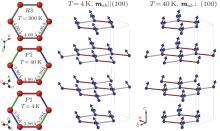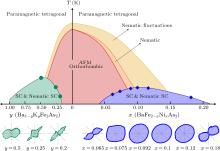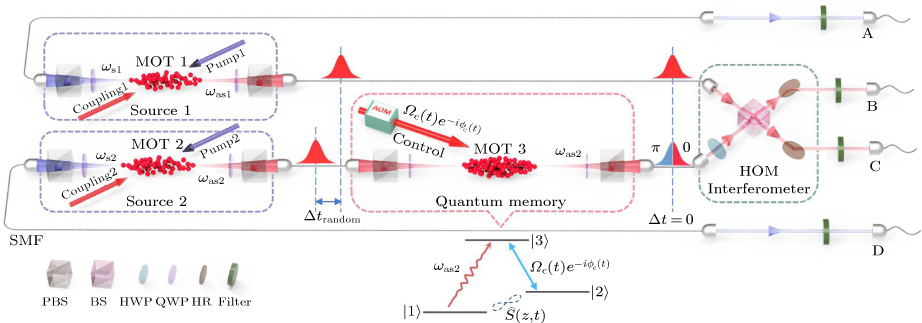|
|
Inelastic Interaction of Double-Valley Dark Solitons for the Hirota Equation
Xiao-Man Zhang, Yan-Hong Qin, Li-Ming Ling, and Li-Chen Zhao
Chin. Phys. Lett. 2021, 38 (9):
090201
.
DOI: 10.1088/0256-307X/38/9/090201
For a scalar integrable model, it is generally believed that the solitons interact with each other elastically, for instance, multi-bright solitons from the nonlinear Schrödinger equation and the Korteweg-de Vries equation, etc. We obtain double-valley dark solitons from the defocusing Hirota equation by the Darboux transformation. Particularly, we report a remarkable phenomenon for the inelastic interaction of the double-valley dark solitons, in contrast to the solitons interacting with each other elastically for a scalar integrable model in previous works. Furthermore, we give the explicit conditions for the elastic collision based on the asymptotic analysis results. It is shown that the double-valley dark solitons could also admit elastic interaction under the special parameters settings.
|
|
|
Reverse Rotation of Ring-Shaped Perturbation on Homogeneous Bose–Einstein Condensates
Peng Gao, Zeyu Wu, Zhan-Ying Yang, and Wen-Li Yang
Chin. Phys. Lett. 2021, 38 (9):
090302
.
DOI: 10.1088/0256-307X/38/9/090302
We numerically study the dynamics of rotating ring-shaped perturbation on two-dimensional homogeneous Bose–Einstein condensates, where a new ring-shaped structure with reverse rotation appears. The reversely rotating mode is directly caused by the existence of the plane wave (namely the homogeneous background). By the modified linear stability analysis method, we quantitatively predict the influence of the background's density on perturbation dynamics, including the velocity, amplitude, and frequency of the two rings. We construct an approximative solution to describe the short-lived dynamics of initial perturbation, which agrees well with our numerical results. Also, after the two rings separate, the transfer of atom number between them becomes linear, and the rate of transfer is impacted by the radial momentum of initial perturbation.
|
|
|
Thermodynamics of the System of Massive Dirac Fermions in a Uniform Magnetic Field
Ren-Hong Fang, Ren-Da Dong, De-Fu Hou, and Bao-Dong Sun
Chin. Phys. Lett. 2021, 38 (9):
091201
.
DOI: 10.1088/0256-307X/38/9/091201
We construct the grand partition function of the system of massive Dirac fermions in a uniform magnetic field from Landau levels, through which all thermodynamic quantities can be obtained. Making use of the Abel–Plana formula, these thermodynamic quantities can be expanded as power series with respect to the dimensionless variable $b=2eB/T^{2}$. The zero-field magnetic susceptibility is expanded at zero mass, and the leading order term is logarithmic. We also calculate scalar, vector current, axial vector current and energy-momentum tensor of the system through ensemble average approach. Mass correction to chiral separation effect is discussed. For massless chiral fermions, our results recover the chiral magnetic effect for right- and left-handed fermions, as well as chiral separation effect.
|
|
|
Perfect $DD^*$ Molecular Prediction Matching the $T_{\rm cc}$ Observation at LHCb
Ning Li, Zhi-Feng Sun, Xiang Liu, and Shi-Lin Zhu
Chin. Phys. Lett. 2021, 38 (9):
092001
.
DOI: 10.1088/0256-307X/38/9/092001
In 2012, we investigated the possible molecular states composed of two charmed mesons [ Phys. Rev. D 88 (2013) 114008; 2012 arXiv:1211.5007 [hep-ph]]. The $D^*D$ system with the quantum numbers of $I(J^P)=0(1^+)$ was found to be a good candidate of the loosely bound molecular state. This state is very close to the $D^*D$ threshold with a binding energy around 0.47 MeV. This prediction was confirmed by the new LHCb observation of $T_{\rm cc}^+$ [see Franz Muheim's talk at the European Physical Society conference on high energy physics 2021].
|
|
|
Development of a Spin-Exchange Optical Pumping-Based Polarized $^{3}$He System at the China Spallation Neutron Source (CSNS)
Chuyi Huang, Junpei Zhang, Fan Ye, Zecong Qin, Syed Mohd Amir, Zachary Norris Buck, Ahmed Salman, Wolfgang Kreuzpaintner, Xin Qi, Tianhao Wang, and Xin Tong
Chin. Phys. Lett. 2021, 38 (9):
092801
.
DOI: 10.1088/0256-307X/38/9/092801
Polarized $^{3}$He neutron spin filters (NSFs) can be used as a vital tool for neutron polarization production and analysis. The China Spallation Neutron Source (CSNS), as one of the major neutron facilities in China, has committed resources to the development of a polarized $^3$He NSF program to support its growing polarized neutron research. A spin-exchange optical pumping (SEOP)-based polarized $^{3}$He system and other necessary hardware for NSF transport has been recently developed. The performance of the system is benchmarked using an in-house developed cell named “Trident”. Neutron beam measurements yield a $^{3}$He polarization of 77% with over 200 h of on-beam relaxation time. Combining this newly developed SEOP system with the recently reported cell fabrication station, CSNS is now capable of the fully self-sustained production of $^{3}$He NSFs that shall support its future neutron polarization research.
|
|
|
Low-Temperature Baking Effect of the Radio-Frequency Nb$_{3}$Sn Thin Film Superconducting Cavity
Ziqin Yang, Shichun Huang, Yuan He, Xiangyang Lu, Hao Guo, Chunlong Li, Xiaofei Niu, Pingran Xiong, Yukun Song, Andong Wu, Bin Xie, Zhiming You, Qingwei Chu, Teng Tan, Feng Pan, Ming Lu, Didi Luo, Junhui Zhang, Shenghu Zhang, and Wenlong Zhan
Chin. Phys. Lett. 2021, 38 (9):
092901
.
DOI: 10.1088/0256-307X/38/9/092901
The Nb$_{3}$Sn thin film cavity, having the potential to be operated at a higher temperature and higher gradient compared to the cavity made from bulk niobium, is one of the most promising key technologies for the next-generation radio-frequency superconducting accelerators. In our work, several 1.3 GHz single-cell TESLA-shaped Nb$_{3}$Sn thin film cavities, coated by the vapor diffusion method, were tested at Peking University and Institute of Modern Physics, Chinese Academy of Sciences. It was observed that the performance of the Nb$_{3}$Sn thin film cavities in the tests without the slow cooling down procedure and the effective magnetic field shielding was significantly improved by using a low temperature baking at 100 ℃ for 48 hours. Although the peak electric field of the cavity remained unchanged, the rapid drop of the unloaded $Q$ value ($Q_{0}$) with the increasing accelerating field ($Q$-slope) was effectively eliminated, resulting in an improvement of the $Q_{0}$ in the intermediate field region by $\sim $8 times. Furthermore, under better test conditions with the shielded magnetic field less than 5 mG and the slow cooling down procedure in the temperature range of 25–15 K, the $Q_{0}$ was still improved by about 20%. Our study shows that the low temperature baking can be an effective supplement to the effective post-treatment for the Nb$_{3}$Sn thin film cavity.
|
|
|
Synchronization and Phase Shaping of Single Photons with High-Efficiency Quantum Memory
Keyu Su, Yunfei Wang, Shanchao Zhang, Zhuoping Kong, Yi Zhong, Jianfeng Li, Hui Yan, and Shi-Liang Zhu
Chin. Phys. Lett. 2021, 38 (9):
094202
.
DOI: 10.1088/0256-307X/38/9/094202
Time synchronization and phase shaping of single photons both play fundamental roles in quantum information applications that rely on multi-photon quantum interference. Phase shaping typically requires separate modulators with extra insertion losses. Here, we develop an all-optical built-in phase modulator for single photons using a quantum memory. The fast phase modulation of a single photon in both step and linear manner are verified by observing the efficient quantum-memory-assisted Hong–Ou–Mandel interference between two single photons, where the anti-coalescence effect of bosonic photon pairs is demonstrated. The developed phase modulator may push forward the practical quantum information applications.
|
|
|
Anomalous Impact of Surface Wettability on Leidenfrost Effect at Nanoscale
Yue Wang, Xiaoxiang Yu, Xiao Wan, Nuo Yang, and Chengcheng Deng
Chin. Phys. Lett. 2021, 38 (9):
094401
.
DOI: 10.1088/0256-307X/38/9/094401
Leidenfrost effect is a common and important phenomenon which has many applications, however there is a limited body of knowledge about the Leidenfrost effect at the nanoscale regime. We investigate the impact of substrate wettability on Leidenfrost point temperature (LPT) of nanoscale water film via molecular dynamics simulations, and reveal a new mechanism different from that at the macroscale. In the molecular dynamics simulations, a method of monitoring density change at different heating rates is proposed to obtain accurate LPT under different surface wettability. The results show that LPT decreases firstly and then increases with the surface wettability at the nanoscale, which is different from the monotonous increasing trend at the macroscale. The mechanism is elucidated by analyzing the competitive effect of adhesion force and interfacial thermal resistance, as well as different contributions of gravity on LPT at the nanoscale and macroscale. The investigations can deepen the understanding of Leidenfrost effect at the nanoscale regime and also facilitate to guide the applications of heat transfer and flow transport.
|
|
|
Magnetic Order and Its Interplay with Structure Phase Transition in van der Waals Ferromagnet VI$_{3}$
Yiqing Hao, Yiqing Gu, Yimeng Gu, Erxi Feng, Huibo Cao, Songxue Chi, Hua Wu, and Jun Zhao
Chin. Phys. Lett. 2021, 38 (9):
096101
.
DOI: 10.1088/0256-307X/38/9/096101
Van der Waals magnet VI$_{3}$ demonstrates intriguing magnetic properties that render it great for use in various applications. However, its microscopic magnetic structure has not been determined yet. Here, we report neutron diffraction and susceptibility measurements in VI$_{3}$ that revealed a ferromagnetic order with the moment direction tilted from the $c$-axis by $\sim $$36^{\circ}$ at 4 K. A spin reorientation accompanied by a structure distortion within the honeycomb plane is observed, before the magnetic order completely disappears at $T_{\rm C} = 50$ K. The refined magnetic moment of $\sim $$1.3 \mu_{\scriptscriptstyle {\rm B}}$ at 4 K is much lower than the fully ordered spin moment of $2\mu_{\scriptscriptstyle {\rm B}}$/V$^{3+}$, suggesting the presence of a considerable orbital moment antiparallel to the spin moment and strong spin–orbit coupling in VI$_{3}$. This results in strong magnetoelastic interactions that make the magnetic properties of VI$_{3}$ easily tunable via strain and pressure.

|
|
|
Manipulation of Dirac Fermions in Nanochain-Structured Graphene
Wen-Han Dong, De-Liang Bao, Jia-Tao Sun, Feng Liu, and Shixuan Du
Chin. Phys. Lett. 2021, 38 (9):
097101
.
DOI: 10.1088/0256-307X/38/9/097101
Graphene has afforded an ideal 2D platform for investigating a rich and fascinating behavior of Dirac fermions. Here, we develop a theoretical mechanism for manipulating the Dirac fermions in graphene, such as from type-I to type-II and type-III, by a top-down nanopatterning approach. We demonstrate that by selective chemical adsorption to pattern the 2D graphene into coupled 1D armchair chains (ACs), the intrinsic isotropic upright Dirac cone becomes anisotropic and strongly tilted. Based on model analyses and first-principles calculations, we show that both the shape and tilt of Dirac cone can be tuned by the species of chemisorption, e.g., halogen vs hydrogen, which modifies the strength of inter-AC coupling. Furthermore, the topological edge states and transport properties of the engineered Dirac fermions are investigated. Our work sheds lights on understanding the Dirac fermions in a nanopatterned graphene platform, and provides guidance for designing nanostructures with novel functionality.
|
|
|
Simultaneous Optimization of Power Factor and Thermal Conductivity towards High-Performance InSb-Based Thermoelectric Materials
Wang Li , Tian Xu , Zheng Ma , Abubakar-Yakubu Haruna, Qing-Hui Jiang , Yu-Bo Luo, and Jun-You Yang
Chin. Phys. Lett. 2021, 38 (9):
097201
.
DOI: 10.1088/0256-307X/38/9/097201
Thermoelectric performance of InSb is restricted by its low Seebeck coefficient and high thermal conductivity. Here, CuCl is employed to optimize simultaneously the electrical and thermal transport properties of InSb. The substitution of Cl for Sb results in enhanced electron effective mass, leading to high Seebeck coefficient of $-159.9$ µV/K and high power factor of 31.5 µW$\cdot$cm$^{-1}$$\cdot$K$^{-2}$ at 733 K for InSb + 5 wt% CuCl sample. In addition, CuCl doping creates hierarchical architectures composed of Cu$_{9}$In$_{4}$, Sb, Cu$_{2}$Sb in InSb, leading to a strengthened phonon scattering in a wide wavelength (i.e., nano to meso scale), thus a low lattice thermal conductivity of 2.97 W$\cdot$m$^{-1}$$\cdot$K$^{-1}$ at 733 K in InSb + 5 wt% CuCl. As a result, a maximum $ZT$ of 0.77 at 733 K has been achieved for the InSb + 5 wt% CuCl sample, increasing by $\sim $250% compared to pristine InSb.
|
|
|
Observation of a Ubiquitous ($\pi, \pi$)-Type Nematic Superconducting Order in the Whole Superconducting Dome of Ultra-Thin BaFe$_{2-x}$Ni$_x$As$_2$ Single Crystals
Yu Dong, Yangyang Lv, Zuyu Xu, M. Abdel-Hafiez, A. N. Vasiliev, Haipeng Zhu, Junfeng Wang, Liang Li, Wanghao Tian, Wei Chen, Song Bao, Jinghui Wang, Yueshen Wu, Yulong Huang, Shiliang Li, Jie Yuan, Kui Jin, Labao Zhang, Huabing Wang, Shun-Li Yu, Jinsheng Wen, Jian-Xin Li, Jun Li, and Peiheng Wu
Chin. Phys. Lett. 2021, 38 (9):
097401
.
DOI: 10.1088/0256-307X/38/9/097401
In iron-based superconductors, the ($0, \pi$) or ($\pi, 0$) nematicity, which describes an electronic anisotropy with a four-fold symmetry breaking, is well established and believed to be important for understanding the superconducting mechanism. However, how exactly such a nematic order observed in the normal state can be related to the superconducting pairing is still elusive. Here, by performing angular-dependent in-plane magnetoresistivity using ultra-thin flakes in the steep superconducting transition region, we unveil a nematic superconducting order along the ($\pi, \pi$) direction in electron-doped BaFe$_{2-x}$Ni$_x$As$_2$ from under-doped to heavily overdoped regimes with $x=0.065$–0.18. It shows superconducting gap maxima along the ($\pi, \pi$) direction rotated by 45$^\circ$ from the nematicity along ($0, \pi$) or ($\pi, 0$) direction observed in the normal state. A similar ($\pi, \pi$)-type nematicity is also observed in the under-doped and optimally doped hole-type Ba$_{1-y}$K$_y$Fe$_2$As$_2$, with $y = 0.2$–0.5. These results suggest that the ($\pi, \pi$) nematic superconducting order is a universal feature that needs to be taken into account in the superconducting pairing mechanism in iron-based superconductors.

|
|
|
Nonlocal Effects of Low-Energy Excitations in Quantum-Spin-Liquid Candidate Cu$_3$Zn(OH)$_6$FBr
Yuan Wei, Xiaoyan Ma, Zili Feng, Yongchao Zhang, Lu Zhang, Huaixin Yang, Yang Qi, Zi Yang Meng, Yan-Cheng Wang, Youguo Shi, and Shiliang Li
Chin. Phys. Lett. 2021, 38 (9):
097501
.
DOI: 10.1088/0256-307X/38/9/097501
We systematically study the low-temperature specific heats for the two-dimensional kagome antiferromagnet, Cu$_{3}$Zn(OH)$_6$FBr. The specific heat exhibits a $T^{1.7}$ dependence at low temperatures and a shoulder-like feature above it. We construct a microscopic lattice model of $Z_2$ quantum spin liquid and perform large-scale quantum Monte Carlo simulations to show that the above behaviors come from the contributions from gapped anyons and magnetic impurities. Surprisingly, we find the entropy associated with the shoulder decreases quickly with grain size $d$, although the system is paramagnetic to the lowest temperature. While this can be simply explained by a core-shell picture in that the contribution from the interior state disappears near the surface, the 5.9-nm shell width precludes any trivial explanations. Such a large length scale signifies the coherence length of the nonlocality of the quantum entangled excitations in quantum spin liquid candidate, similar to Pippard's coherence length in superconductors. Our approach therefore offers a new experimental probe of the intangible quantum state of matter with topological order.

|
|
|
Elastic Modulus, Hardness, and Fracture Toughness of Li$_{6.4}$La$_{3}$Zr$_{1.4}$Ta$_{0.6}$O$_{12}$ Solid Electrolyte
Shan Hu, Pengyu Xu, Luize Scalco de Vasconcelos, Lia Stanciu, Hongwei Ni, and Kejie Zhao
Chin. Phys. Lett. 2021, 38 (9):
098401
.
DOI: 10.1088/0256-307X/38/9/098401
Li$_{6.4}$La$_{3}$Zr$_{1.4}$Ta$_{0.6}$O$_{12}$ (LLZTO) is a promising inorganic solid electrolyte due to its high Li$^{+}$ conductivity and electrochemical stability for all-solid-state batteries. Mechanical characterization of LLZTO is limited by the synthesis of the condensed phase. Here we systematically measure the elastic modules, hardness, and fracture toughness of LLZTO polycrystalline pellets of different densities using the customized environmental nanoindentation. The LLZTO samples are sintered using the hot-pressing method with different amounts of Li$_{2}$CO$_{3}$ additives, resulting in the relative density of the pellets varying from 83% to 98% and the largest grain size of $13.21 \pm 5.22$ µm. The mechanical properties show a monotonic increase as the sintered sample densifies, elastic modulus and hardness reach $158.47 \pm 10.10$ GPa and $11.27 \pm 1.38$ GPa, respectively, for LLZTO of 98% density. Similarly, fracture toughness increases from 0.44 to 1.51 MPa$\cdot$m$^{1/2}$, showing a transition from the intergranular to transgranular fracture behavior as the pellet density increases. The ionic conductivity reaches $4.54 \times 10^{-4}$ S/cm in the condensed LLZTO which enables a stable Li plating/stripping in a symmetric solid-state cell for over 100 cycles. This study puts forward a quantitative study of the mechanical behavior of LLZTO of different microstructures that is relevant to the mechanical stability and electrochemical performance of all-solid-state batteries.
|
20 articles
|




